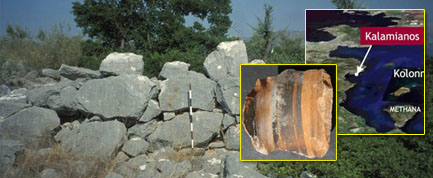Ancient Greek Outpost Discovered, Spectacularly Preserved

Long before Homer wrote the Iliad, the real-life progenitors of the epic poem's characters might have visited a small outpost on the Greek coast.
Archaeologists have discovered a spectacularly preserved ancient harbor town of the Mycenaeans, the civilization on which many ancient Greek legends were based. Though the settlement was built 3,500 years ago, hundreds of walls are still standing.
The site, which is partially underwater, lies along a rocky, isolated stretch of shoreline. Scientists suspect it may have been built as a military outpost.
"This is really a remarkable find," said Daniel Pullen, an archaeologist at Florida State University who discovered the site. "It is rare indeed to locate an entire town built during the Late Bronze Age that shows this level of preservation."
Unusually intact
The site is unique because the remains of most Mycenaean towns are completely buried by now under a few millennia's worth of dirt and detritus. This one stands above ground, with many walls incredibly intact.
"Usually to excavate Mycenaean buildings you have to dig underground," Pullen told LiveScience. "What we have here is the plan of an entire town preserved for us. We have the fortification wall, we have all these buildings, and we can often see where the doorways would be. We can see how the buildings relate to each other, because we have obvious alleyways and streets."
Get the world’s most fascinating discoveries delivered straight to your inbox.
When Pullen and his team first inspected the walls at the site, they counted more than 900 of them, he said.
The structures are mostly aligned along a grid, leading scientists to think the city was built all at once, as opposed to gradually over time, which would likely result in a more random arrangement of buildings.
"We think it was built for a specific purpose," Pullen said. "We have evidence that there were a few people at this site for a long time before. Then at some particular point people came in and established this as a new outpost or maybe a naval or military base. And they brought their engineers and builders with them and constructed the main part of the site all at once."
Another clue that the city was a military base is the lack of agricultural evidence at the site, and the fact that there is probably not even enough farmable land nearby to support the number of people the scientists think lived there.
Trojan War heroes?
Pullen and his team call the settlement Korphos-Kalamianos. It lies on the coast of the Saronic Gulf in the western Aegean Sea about 60 miles (100 km) southwest of Athens, and about 40 miles (65 km) east of Mycenae, one of the major Mycenaean capitals when Korphos-Kalamianos was active.
The Mycenaean civilization thrived in Greece from 1600 to 1100 B.C., and served as the historical setting of Homer's epics and many ancient Greek myths. Although historians debate whether or not the Trojan War was a real event (many think the stories of Helen of Troy and the Trojan horse are likely myths), if it did occur, it would have been shortly after Korphos-Kalamianos was built.
Mycenaeans were mostly peasants, ruled by a royal warrior class.
"There were a number of wealthy nobles beneath the king who owned land and were involved in various economic activities," Pullen said. "The majority of people were involved in agriculture. We know from the Mycenaean tablets that the palace was very interested in sheep to produce wool for fine textiles, and they produced lots of olive oil and lots of wine for feasts."
Though Korphos-Kalamianos did not seem to have a palace, many of the structures were built in palace-style architecture, leading the scientists to think that nobles or representatives of the King would have stayed there. Perhaps the site was an official outpost of the palace at Mycenae, Pullen suggested.
Underwater secrets
The researchers have a few hypotheses for why the city is so well preserved and why the walls are still above ground. Perhaps earthquake activity shook off most of the land covering the ruins over the years, Pullen said. Or maybe farming in the area caused soil to erode, leaving the buildings exposed.
To further probe the mysteries of the lost seaside town, the research team plans to take underwater measurements of the surface of the ocean floor near Korphos-Kalamianos to reconstruct the shape of the coastline during the Late Bronze Age. The archaeologists think the area once had a useful natural harbor, which was probably the lure of the site in the first place.
Pullen first discovered the ruins in 2001 and recently discussed his findings in a presentation to the annual meeting of the Archaeological Institute of America in January 2008.
- Top 10 Ancient Capitals
- Land of Homer's 'Odyssey' Said Found
- Bulgarians Find Gold Treasure to Match Troy



